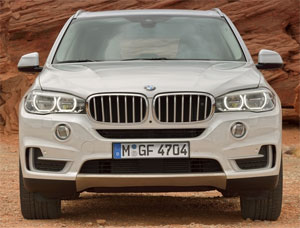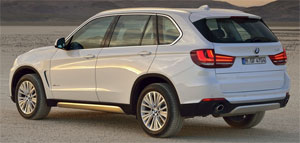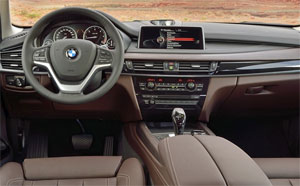2014 BMW X5
The BMW X5 arrived for the 2000 model year; a time when rival European brands were bringing high dollar sport utes to an American market that couldn’t buy up them fast enough. While the X5 has proven very popular with more than 1.3-million sold, competition grows more intense. Plus many ute buyers are downsizing to save on fuel costs. So let’s see if an all-new X5 factors in all the changes.
The mid-size 2014 BMW X5 is actually the 3rd generation of BMW’s original Sports Activity Vehicle. And while BMW has expanded into smaller segments with both the X3 and X1, it’s still the X5 that makes up the bulk of their utility sales in the U.S.
Perhaps the biggest news is that a rear-wheel-drive only sDrive X5 is now available for those that have no need for all-wheel-drive. The new-gen looks are in a word, evolutionary. But tweaks such as new headlights with flattened LED trim rings, and the increasing amount of aero elements will let those “in the know”, know you’ve upgraded.
 While wheelbase carries over at 115.5 inches, overall length grows by 2-inches to 193.2. It loses a little in both overall height and ride height, giving this X5 a more hunkered down look. But like the guy at the gym with the cut-off sleeves, the very high mounted fog lamps and traditional twin kidney grilles try a little too hard to look cool.
While wheelbase carries over at 115.5 inches, overall length grows by 2-inches to 193.2. It loses a little in both overall height and ride height, giving this X5 a more hunkered down look. But like the guy at the gym with the cut-off sleeves, the very high mounted fog lamps and traditional twin kidney grilles try a little too hard to look cool.
Thick body lines are still present along the sides, only now they emanate from a new front fender vent. All-in-all, not a bad looking redesign, though some of our staff did feel it appears more mini-van-ish than before. We’re all fans of the dual tailgate setup, as it makes loading heavy and bulky items easier.
While off-road credentials are probably not a high priority, the full-time intelligent all-wheel-drive system uses lots of electronic wizardry to be very capable. And should do just fine if the pending zombie apocalypse does arrive, or just on the snowy roads that we encountered here in the Mid-Atlantic this past winter.
Regardless of driving mission, you’ll find the X5 rides more like a BMW sedan than any ute. The incredibly smooth shifts of the standard 8-speed automatic transmission, and one of the most unobtrusive start/stop systems we’ve sampled, add positively to the experience.
 And as you would expect, it’s a great handling experience as well. Though as with most BMW’s, we mourn the lack of steering feel. But it’s hard to argue with the results, as steering is still impressively quick.
And as you would expect, it’s a great handling experience as well. Though as with most BMW’s, we mourn the lack of steering feel. But it’s hard to argue with the results, as steering is still impressively quick.
Driven aggressively, the X5 begins to feel more like an SUV, but still one that handles better than most. And this 6-banger xDrive35i certainly hooks up and launches like few SUVs. It doesn’t feel overly powerful, just a civilized whoosh of acceleration taking you to 60 in 6.2-seconds. Power continues to pour on smoothly as you work your way down the track, with firm, quick shifts coming right at red line until you clear the ¼-mile in 14.8-seconds at 95 miles-per-hour.
Powertrain options are as before, gasoline and diesel fueled inline-6s and a 4.4–liter V8 xDrive50i. The V8 is updated while the diesel in the xDrive35d is all new. But, in our test xDrive35i, the 3.0-liter gas I6 soldiers on, pumping out 300–horsepower and 300 lb-ft. of torque with the help of BMW’s TwinPower turbo.
 Dropping the hood and opening the doors, the highlight of the interior is easily the huge 10-inch hi-res. screen indiscreetly plopped down on the dash. It’s controlled by iDrive of course, and we think BMW has finally struck a good balance with logically placed traditional controls; making tapping into iDrive central only necessary for more detailed requests. A new touchpad write-on feature helps as well.
Dropping the hood and opening the doors, the highlight of the interior is easily the huge 10-inch hi-res. screen indiscreetly plopped down on the dash. It’s controlled by iDrive of course, and we think BMW has finally struck a good balance with logically placed traditional controls; making tapping into iDrive central only necessary for more detailed requests. A new touchpad write-on feature helps as well.
Seats, front and rear are firm, supportive, but comfortable. Back seat room is adequate but far from generous. Still, the soft close doors are a nice touch.
Government Fuel Economy Ratings are 18-City, 27-Highway, and 21-Combined. We averaged 20.2 miles-per-gallon of Premium. That Energy Impact Score is so-so at 15.7-barrels of annual oil use with 6.9 tons of CO2 emissions.
Yea, we know fuel economy could be better, but we just love the power and effortless feel of the gas I6. But, go the xDrive35d diesel and you gain 20% on MPGs and lose little else. And, the diesel is only $1,500 more than our tester, and volume leader xDrive35i which starts at $56,025.
The 2014 BMW X5 is indeed a sweet ride. When it comes to all out luxury, we still prefer a Range Rover, but the X5 actually appeals to a different buyer. One that needs an SUV, but really wants a BMW sport sedan. And, that will keep the X5 a major market factor for years to come.
Specifications
- Engine: 3.0-liter
- Horsepower: 300
- Torque: 300 lb-ft.
- 0-60 mph: 6.2 seconds
- 1/4 mile: 14.8 seconds @ 95 mph
- EPA: 18 mpg city/ 27 mpg highway
- Energy Impact: 15.7-barrels of oil/yr
- CO2 Emissions: 6.9 tons/yr
2024 Toyota Land Cruiser
Toyota’s Go Anywhere Globetrotter Returns To U.S.
Every once in a while, we all need a reset. A time to get back to basics and prioritize the things that really matter. Well, for the Toyota Land Cruiser that time is now. So, let’s find out if that means bigger and better things for Toyota’s iconic off-roader.
The Toyota Land Cruiser’s status among the global off-road community is legendary, and it’s hard to imagine there’s any corner of the earth where a Land Cruiser hasn’t kicked up a little dust or mud. Well, 2024 sees the return of the Land Cruiser to the U.S. market after a 3-year hiatus, getting a major reset for the journey.
The reset comes mostly by no longer being based on the large three-row “300-series” chassis, but a new version of the smaller “200-series,” now known as the J250. As with the latest Tacoma, it uses the Tundra pickup’s full-size steel frame.
While the main Land Cruiser model, which goes by simply Land Cruiser, is packed full of luxury and convenience features, there is also a stripped-down model known as the 1958, honoring the first year the Land Cruiser made landfall here in North America. And it is that 1958 we have here, and we were glad to see it, as it also celebrates the original’s back-to-basics approach as a blank canvas for you to personalize as you tackle more and more adventures.
Not that it’s fully stripped down, as 8-inch touchscreen infotainment, a 7-inch full-color multi-information display, and automatic climate control are still standard. Plus, some seriously durable materials, and great heated cloth front seats that throw off some get serious 1990s Tacoma vibes.
But outside, there’s a definite lack of flashy trim and basic looking 18-inch wheels with Yokohama Geolander all-season tires; plus, big chunky bumpers and tilt-up back glass, which is a rarity that we appreciate. Though there is a little too much plastic in places that are sure to see some abuse if you do any significant off-roading.
It even feels a little rough around the edges, but for us it just adds to the rugged old-school utility vibe in a good way.
We did just that, both here in the Mid-Atlantic as well as in the California desert; and while there are some tech-forward driving aids, the actual hardware is in most cases plenty to get things done. That includes standard full-time dual-range four-wheel-drive, locking center and rear diffs, and 8.7-inches of ground clearance. A front stabilizer bar disconnect is also available to allow for increased articulation.
Who needs a V6 or even a V8 when you’ve got Toyota’s i-FORCE MAX setup at your disposal with 326 horsepower and 465 lb-ft of torque coming from a 2.4-liter turbo-four with an electric motor sandwiched between the engine and its eight-speed automatic transmission. Low speed torque delivery is impressive. It even feels a little rough around the edges, which may be a turn off to some, but for us it just adds to the rugged old-school utility vibe in a good way.
And it certainly feels quicker than an off roader needs to be, with an instant torque dump as soon as we eased on the throttle at our Mason Dixon test track; helping us get to 60 in 8.1 seconds and through the quarter-mile in 16.3 seconds at 86 mph. Considering the Land Cruiser’s terrain conquering mission, it behaved quite well in our handling course; it was plenty responsive to inputs, with less body roll than we expected and plenty of grip from the tires. The steering was light and quick but as expected didn’t provide much feel. Other than significant nosedive, braking performance was exceptional. Only 107-feet to panic stop us from 60 mph.
With the shift to the smaller size, there’s no more third row available, and cargo capacity now comes in at 46.2 cubic-feet with a max of a still healthy 82.1. Now, the best part of the Land Cruiser’s return is the entry price of $57,445. That’s about 30-grand less than what the last Land Cruiser went for back in 2021.
Whether it’s over the top fashion trends, mullets, or zombies; just when you think they’re dead, they come roaring back to life. Of course, we’re much happier to see the resurrection of this 2024 Toyota Land Cruiser than any of those things. Toyota is one brand that still recognizes the value of full-framed rugged rigs and has also acknowledged that sometimes less really is more. The Godfather of Toyota off-roading is back and better than ever.







